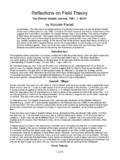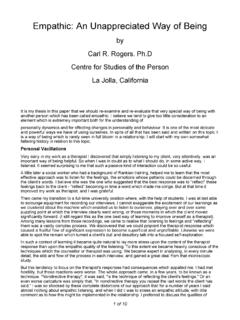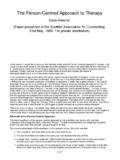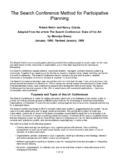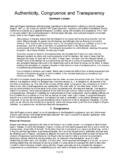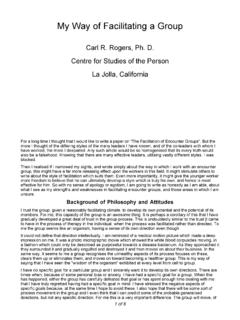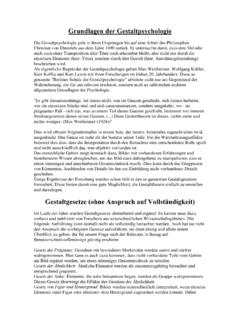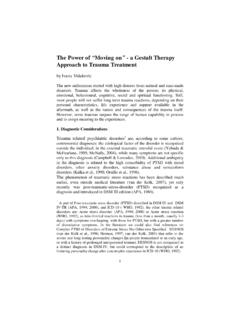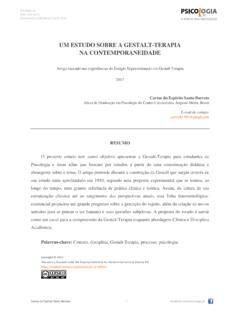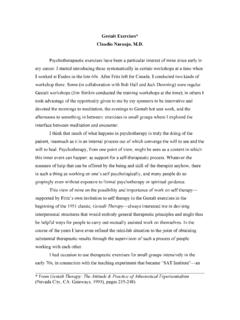Transcription of Gestalt group process - Elements UK
1 Gestalt group ProcessTaken from: "Beyond the Hot Seat, Gestalt Approaches to group " - Edited by Bud Feder and Ruth Ronall, chapter KepnerForegroundIn this chapter I describe what I call " Gestalt group process ," which integrates the principles and practices of Gestalt therapy and group dynamics. It is a model in which the leader wears bifocal lenses, paying attention to the development of the individuals in the group and to the development of the group as a social system. From this perspective, the group is regarded not just as a collection of individuals, but as a potent psychosocial environment which profoundly affects the feelings, attitudes and behaviours of the individuals in that system, and conversely, is profoundly affected by the feelings, attitudes and behaviours of the individual in that system. The chapter is divided into two sections: The first part deals with some personal and historical antecedents, and the second part with the theory and practice of this bifocal approach to personal development in I.
2 BackgroundThis chapter actually began five years ago, when, halfway through a three day Gestalt personal growth workshop I was leading, a disgruntled member jumped up from his chair, strode in front of me and shouted "This is not a real Gestalt group , and you are not a real Gestalt leader!". I took a deep breath, centred myself in my chair, and asked him to specify his complaints. In rapid fire succession, he catalogued them. He said that I had not used the empty chair, not even once, that I had discouraged him from working on a dream at the opening session until more support for this had developed in the group , that I had allowed individuals to give feedback to one another and to engage in other forms of "bullshit."Needless to say, I had mixed reactions to this confrontation. One part of me felt defensive and wanted to give him a detailed resume of my credentials as a Gestalt therapist and group leader. Another part, the group leader, welcomed the challenge. His behaviour meant that the group , through one of its members, was testing out the boundaries of authority.
3 By taking a stand against me as leader, this person was setting a new norm and perhaps moving the group toward increasing differentiation and autonomy. I was from this perspective that I responded. However, I was left with strong feelings of frustration mixed with despair. The 1 of 10question that formed in my mind was, "How has it come about that so many have mistaken the medium for the message in Gestalt , and have confused the techniques and gimmicks for the essence of the method?" In this chapter, I attempt to answer my own question, and to deliver the lecture on Gestalt group process I wanted to give five years ago to this questioning retrospect, it seems wise that I chose to repress that lecture. At that time, I was struggling to integrate what I had learned about group from colleagues at the Gestalt Institute of Cleveland and from staff persons I had worked with at the National Training Laboratories. I was assimilating the powerful experiences in groups and community that had occurred for me as a participant of the Arica Training Institute in San Francisco.
4 When I returned to Cleveland from the West Coast, I intentionally changed my style of leadership from being a Gestalt "therapist" to being a teacher of process on an intrapersonal, interpersonal group level. I had not abandoned individual work in a group , but expanding awareness of "what is" to include these other dimensions. Having been socialised as a professional in a variety of types of groups I was trying to integrate what appeared to be a number of differences, conflicts and polarities in relation to individuals and systems. The more familiar I became with each polarity, the more I began to realise that I did not have to make an either or choice. Having struggled with these dilemmas for several years, I now believe that I have come to what is a serviceable integration of these polarities for me, which I trust will be of some service to colleagues who are concerned with some of these same model is based on two assumptions: first, that the development of the creative potential in individuals is dependent on and related to a well functioning and healthy social system; and second, that groups, individuals, go through stages of development in the process of change that can be roughly characterised behaviourally as a move from dependence through counterdependence to independence.
5 This model then requires a change in leader role and activity over time. It differs substantially from the popular notion of Gestalt groups, namely, that of individual therapy done in a group setting, as practised by Fritz Perls and others in their workshops, and so widely communicated through films and video-tapes. Paradoxically, it builds on what Fritz articulated in the theory of Gestalt but did not practice, for reasons which I shall go into is not generally understood is that both Gestalt therapy and group dynamics developed from common roots in psychology and philosophy. So before describing the way in which this integrated group process model works, I want to fill in some of this important historical , the concept of contact and contact boundaries, so central in Gestalt theory, is a statement about the individual organism in an environmental field, and the interaction of each with the other. Laura Perls (1976, p. 223) describes contact as a boundary phenomenon between organism and environment: "It is the other acknowledgment of, and the coping with the other, the not-me, the different, the strange.
6 "In Gestalt theory we also consider the individual and the environment as a unified field or system, in which all parts are interdependent, so as a unified field or system, in which all parts are interdependent, so that a change in one part of the total affects all other parts, This relation between the individual and the environment is succinctly stated by 'Fritz Perls (1973, p. 16) when he speaks of the contact boundary:No individual is self-sufficient; the individual can exist only in an environmental field. The individual is inevitably, at every moment, a part of some field, which includes both him and his environment. The nature of the relationship between him and his environment determines the human being's behaviour. With this new outlook, the environment and the organism stand in a relationship of mutuality to one quotation, or a similar one, could as easily have been taken from the writings of Kurt Lewin, the seminal thinker in the field of group dynamics. This is not surprising, considering that both of these men derived their models of personal and social change from two sources: the work of the German psychologists, Koffka, K hler and Wertheimer (whose experimental studies in perception and learning became the foundation of Gestalt Psychology); and the contribution of a German researcher and physician, Kurt Goldstein) who extended the principles to the study of the whole person.
7 While each of these men, Lewin and Perls, were dedicated to changing behaviour, they developed their ideas into what may appear to be very different and seemingly polarised fields of application; individuals and systems. Lewin was a social psychologist, and although he did not lose sight of the individual, what became "figural" for him was the social environment. The major goal for him was social change. His work as a scholar and research scientist provided the theoretical foundations of the field of applied behavioural science, which includes what is now known as group dynamics, organisational development and large systems was a physician and psychotherapist. For him, the individual was "figural" and individual change the major goal of his method. Perls, like Lewin, saw the individual from a systems perspective, but he focused in 2 of 10on the phenomenology of the intrapersonal system. Indeed, the major goal in Gestalt therapy is to "heal the splits" within, the personal sub systems; mind, body and soul, and integration is defined as all parts being unified and available for contact with the the fact that Lewin and Perls focused on different aspects of the total person-environment configuration, it is no wonder that the followers of each have tended to ignore or neglect the work of the other.
8 Although Gestalt therapy and group dynamics developed simultaneously in the United States, they ran parallel rather than intersecting courses. Perls acknowledged the contribution of Lewin to Gestalt psychology, but remained an individualist and an individual therapist throughout his career. He never claimed to be doing group therapy. In a talk delivered to the American Psychological Association in September, 1966, he spelled out the ways in which he differed from group therapists and encounter group leaders:In contrast to the usual type of group meeting, I carry the load (the session, by either doing individual therapy or conducting mass experiments. I often interfere if the group plays opinion and interpretation games or has similar purely verbal encounters. In the Gestalt workshop, anyone who feels the urge can work with me. I am available, but never pushing. A dyad is temporarily developed between myself and the patient; but the rest of the group is fully involved, though seldom as active participants.)
9 Mostly they act as an audience which is stimulated to do quite a bit of silent self-therapy (Perls, 1967, p. 309).However, although Perls expressed his preference for individual therapy in a group setting, in that same paper he said that he considered individual therapy to be out of date, and that it should be replaced by group workshops. Through his many years of experience he had discovered the power of a group in the process of individual change, but he did not, or could not, exploit this learning. For Perls, the participants in a workshop were a collection of individuals. He used them as an audience, regarding them as an important presence or social environment that could be used in the service of the needs of the individual; the participants were discouraged from becoming a particular model of one-to-one therapy had another raison d'etre, beyond that of personal preference. The original and explicitly understood goal of Gestalt workshops in the 1950s and early '60s was to train mental health professionals in the theory and methods of Gestalt as it applied to individual therapy.
10 Fritz and Laura Perls invented this strategy of experiential learning, believing that a method which stressed the phenomenology of the "here and now" needed to be experienced in the here-and-now. This turned out to be a very creative strategy for communicating and teaching Gestalt as a new theory and method of practice, especially in view of the professional scene that Laura and Fritz Perls stepped into when they arrived in New York City in 1947 to establish their that time, the psychoanalytic approach was firmly entrenched in the mental health training institutions, supported by a vast literature and a host of journals and professional societies devoted exclusively to the analytic approach. By contrast, only two books in Gestalt therapy had been published by 1952, when the New York Gestalt Institute was established: Ego, Hunger and Aggression by F. Perls (1947) and Gestalt Therapy by Perls, Hefferline and Goodman (1951). The workshop method, developed by the Perls and later used by, among others, Isador From, Paul Goodman, and Paul Weisz, proved to be a dramatic and effective teaching model and a powerful way of recruiting mental health professionals for training.
